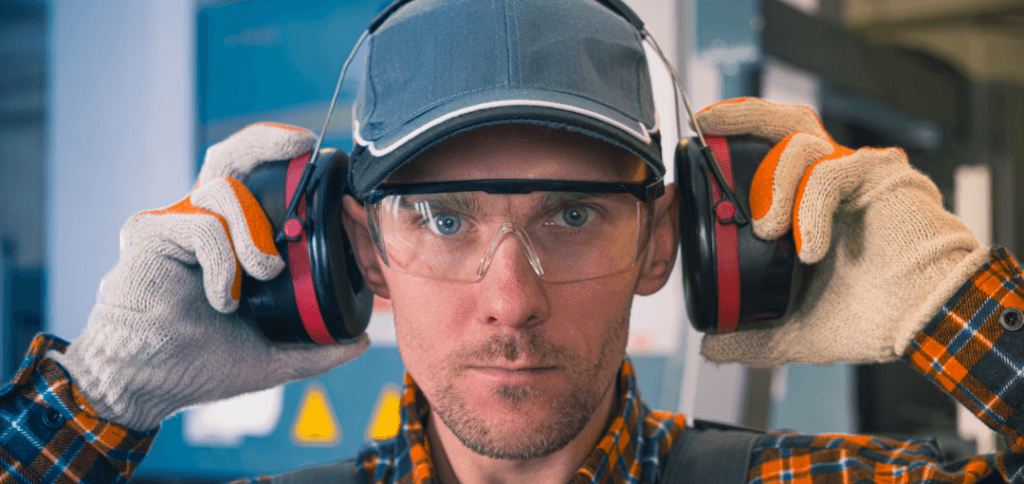Work-induced hearing loss is a serious but preventable issue affecting millions of workers. According to the Centers for Disease Control and Prevention (CDC), about 22 million workers are exposed to potentially harmful noise levels each year. From construction sites to factory floors, and even sports venues, hearing loss is a serious issue.
Implementing on-site workplace hearing conservation programs can protect employees’ hearing and improve workplace safety. Let’s explore how the Occupational Safety and Health Administration (OSHA) regulations guide hearing conservation and how Mobile Health can help you comply with these requirements in your workplace through our occupational health services.
What Is the OSHA Hearing Conservation Program?
OSHA’s Hearing Conservation Program is a set of guidelines and requirements aimed at preventing hearing loss among employees exposed to hazardous noise levels. Under OSHA’s Noise Standard, any workplace where noise exposure reaches or exceeds 85 decibels averaged over an 8-hour workday must implement a workplace hearing conservation program.
This standard is designed to prevent initial occupational hearing loss, preserve existing hearing, and provide employees with the knowledge and hearing protection necessary to protect themselves.
OSHA mandates employers to assess workplace noise levels and reduce exposure through engineering controls, administrative controls, or hearing protection devices (HPDs). These steps ensure that the occupational noise received by employees’ ears stays within safe levels, minimizing the risk of long-term hearing damage.
Key Elements of an OSHA Hearing Conservation Program
Here are the key components that OSHA emphasizes in workplace hearing conservation programs:
Noise Level Monitoring
Employers must regularly measure noise levels in the workplace to identify areas where exposure exceeds permissible limits. Tools like sound level meters and noise dosimeters can help monitor these levels effectively.
Audiologic Testing
Baseline and periodic hearing tests are essential to monitor employees’ hearing health and detect any changes over time. Audiometric tests help identify any hearing loss early, whether it’s work-related or due to other causes.
Hearing Protection
OSHA outlines that employers must provide suitable hearing protection devices to employees exposed to harmful noise levels. This might include earplugs, earmuffs, or custom-fitted devices depending on the level and type of noise exposure.
Training and Education
Employees need to understand the risks of noise exposure and the importance of using hearing protection. Training should cover the effects of noise on hearing, the proper use of hearing protection devices, and strategies to minimize exposure.
Recordkeeping
Employers must maintain comprehensive records of noise exposure measurements and audiometric test results. This is essential for tracking employee exposures and evaluating the effectiveness of the workplace hearing conservation program over time.
Our Hearing Conservation Program Services
At Mobile Health, we offer a range of hearing conservation program services designed to help employers implement and maintain effective workplace hearing conservation programs. Here’s how we can support you:
Audiologic Testing
We conduct baseline and annual hearing tests that comply with OSHA regulations. Our tests identify work-related versus non-work-related hearing loss, ensuring accurate diagnosis and appropriate action.
Hearing Protection Solutions
We assist in selecting and providing the most suitable hearing protection devices for your team, tailored to the specific noise hazards in your workplace.
Hearing Protection Fit Testing
To ensure maximum effectiveness, our fit testing services measure how well hearing protection fits and reduces noise, as recommended by OSHA during an employee’s first baseline exam.
Training and Education
Our training programs educate employees on the significance of hearing conservation and the correct use of hearing protection devices.
Recordkeeping Services
We provide easy-to-use digital tools through our Client Portal, allowing you to maintain detailed, OSHA-compliant records of all audiometric test results.
Employee Hearing Tests with Mobile Health
At Mobile Health, we offer employee hearing tests tailored to meet the needs of different industries, whether you require pre-employment hearing screenings or annual employee hearing tests to stay compliant with OSHA regulations.
Auditory Acuity Screening
This employee hearing test evaluates how well an employee can hear and understand speech at common speech frequencies. During the test, a sound probe is placed in the ear, and the individual indicates when they hear the sound. This screening helps detect potential hearing issues that could impact communication and safety on the job.
Pure Tone Test and Audiogram
Our pure tone test determines the softest sound an employee can hear at various pitches. The results are then recorded on an audiogram, a visual graph that shows any hearing loss and its severity. This test is crucial for monitoring employees’ hearing health over time and identifying any work-related hearing loss early.
Protect Your Team with Mobile Health
At Mobile Health, we’re here to make OSHA compliance and employee hearing protection straightforward, efficient, and effective. With a Certified Occupational Hearing Conservationist (COHC) on our team, we offer specialized expertise in creating workplace hearing conservation programs. Learn more about our hearing conservation program services and other occupational health services to see how we can help you protect your team’s hearing while maintaining compliance with OSHA standards.
-
 Written by:
Written by:
Tricia Chen-Weis, RNTricia Chen-Weis is a seasoned healthcare professional with a passion for operational excellence and patient care. Joining Mobile Health in August 2019, Tricia quickly made her mark improving patient care and clinical operations as Site Manager in Mobile Health’s 36th Street and Staten Island location. With a bachelor's degree from the University of The West Indies and a nursing degree from Monroe College, Tricia's educational foundation provided her with the knowledge and skills necessary to...
